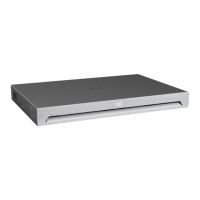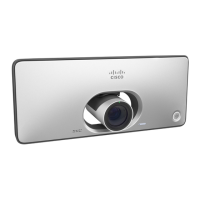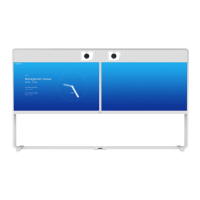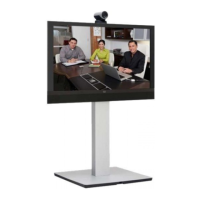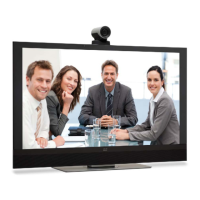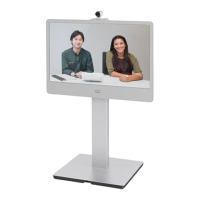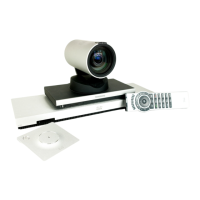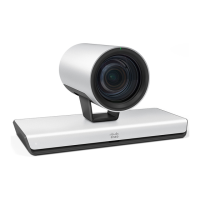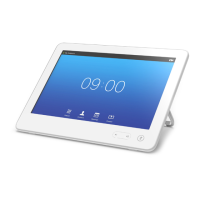
Do you have a question about the Cisco TelePresence Touch 10 and is the answer not in the manual?
| Resolution | 1280 x 800 |
|---|---|
| Touch Technology | Capacitive |
| Compatibility | Cisco TelePresence Systems |
| Power | Power over Ethernet (PoE) |
| Operating Temperature | 0°C to 40°C (32°F to 104°F) |
| Relative Humidity | 10% to 90% (non-condensing) |
| Display Size | 10.1 inches |
| Connectivity | Ethernet |
| Mounting | Tabletop |
| Weight | 0.9 kg (1.98 lbs) |
| Storage Temperature | -20° to 60°C (-4° to 140°F) |
Guidance on optimizing video conference quality and etiquette for successful meetings.
Advice on using camera presets, loudspeaker volume, and monitor brightness settings.
Explanation of how to log into video systems with personal credentials for call routing.
Steps to initiate a call by selecting a contact from your saved lists.
Details on the three contact lists: Favorites, Directory, and Recents.
Instructions on modifying contact details before placing a call.
Information on why and how to edit contact entries for successful calls.
How to dial contacts directly using their name, number, or IP address.
Methods for initiating calls, including using the virtual keyboard and dialing extensions.
How to answer or decline incoming calls when the system is idle.
Explains actions for incoming calls: accept, decline, or ignore.
Procedure for handling incoming calls when already engaged in a call.
Details on accepting a second call while on an active call.
Steps to end your participation in a video call or conference.
Information on how ending a call affects single-party vs. multi-party calls.
Instructions for placing a call on hold and restoring it.
Uses for putting calls on hold, such as transfers or consultations.
Guide to transferring an active call to another participant consultatively.
Explanation of the consultative transfer process.
How to prevent incoming calls while still being able to make outgoing calls.
Details on the Do Not Disturb feature and its potential time-out setting.
Setting up automatic forwarding of all incoming calls to voicemail or another receiver.
Information on the automated call forwarding option.
How to access the dial pad during an active call for extensions or PINs.
Context for using the keypad during a call, such as for PIN entry.
Steps to add more people to an ongoing video call to form a conference.
Information on the system's capability to support multi-party video conferences.
How to remove a participant from an active conference call.
Notes on conference host roles and participant removal.
Instructions for sharing content or controlling calls wirelessly using a personal device.
Details on the Proximity feature, including app requirements and ultrasound usage.
How to share presentations or other content during a video call.
Information on content sharing capabilities and HDCP content handling.
Steps for presenting content in local meetings without an active call.
Overview of presenting content in local meetings using the system.
How to adjust the screen layout during content sharing for optimal viewing.
Explanation of typical presentation layout options.
Procedure for joining pre-arranged video meetings directly from the system.
Notes on how scheduled meetings appear and how to join them.
Overview of the different contact lists available on the system.
Explanation of the purpose and content of Favorites, Recents, and Directory.
How to add a participant to your Favorites list during an active call.
Description of the Favorites list and how it can be populated.
Steps to add contacts to your Favorites list when not in a call.
Details on the Favorites feature and its population sources.
How to access and view camera adjustment menus, presets, and controls.
Overview of camera settings for zoom, pan, tilt, and selfview.
Instructions for creating custom camera positions (pan, tilt, zoom).
Explanation of predefined camera positions for quick adjustments.
Steps to modify existing camera position presets.
Guidance on altering camera preset names and positions.
How to enable and use the automatic speaker tracking feature for cameras.
Details on how speaker tracking works with microphones and camera systems.
How to use the Presenter Track feature to follow a speaker.
Explanation of the Presenter Track feature and its setup.
How to manage your camera's view using presets or manual pan, tilt, and zoom.
Information on managing camera presets and manual adjustments.
How to turn the selfview on/off and adjust its display.
Details on managing the selfview display and its options.
Steps to maximize or minimize the selfview Picture-in-Picture display.
Reasons for resizing the selfview to improve participant visibility.
How to reposition the selfview display on the screen.
Reasons for moving the selfview to avoid blocking important screen content.
How to control the cameras of other participants in a video call.
Information on controlling remote cameras and FECC limitations.
How to access system information and configuration settings.
Overview of system information, wizards, and web interface access.
